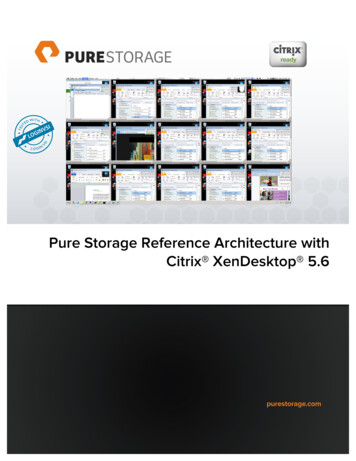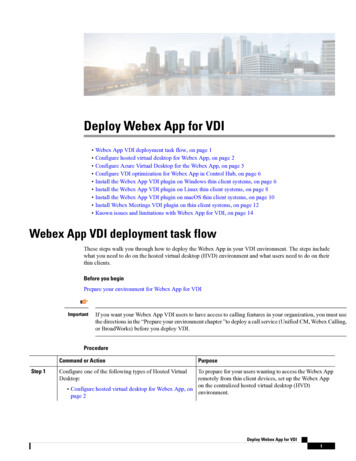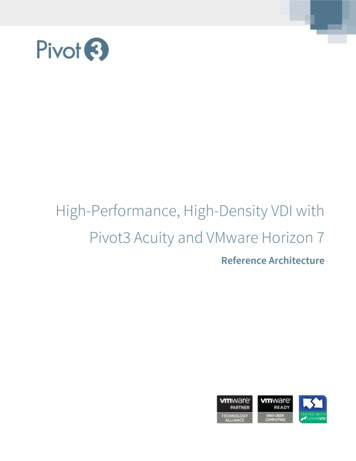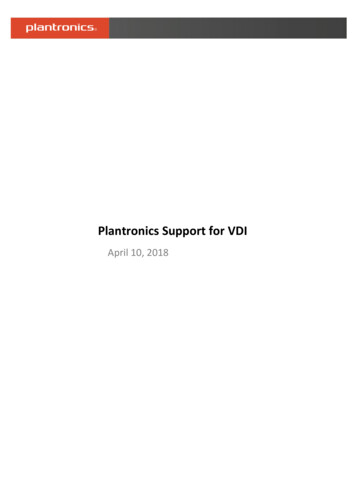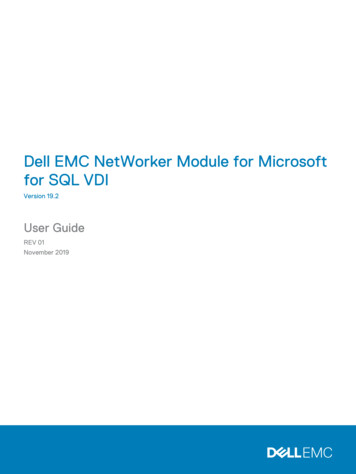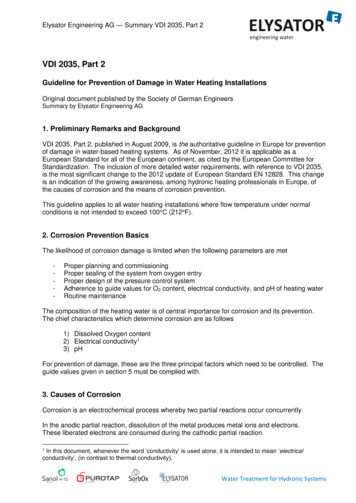
Transcription
Elysator Engineering AG — Summary VDI 2035, Part 2VDI 2035, Part 2Guideline for Prevention of Damage in Water Heating InstallationsOriginal document published by the Society of German EngineersSummary by Elysator Engineering AG1. Preliminary Remarks and BackgroundVDI 2035, Part 2, published in August 2009, is the authoritative guideline in Europe for preventionof damage in water-based heating systems. As of November, 2012 it is applicable as aEuropean Standard for all of the European continent, as cited by the European Committee forStandardization. The inclusion of more detailed water requirements, with reference to VDI 2035,is the most significant change to the 2012 update of European Standard EN 12828. This changeis an indication of the growing awareness, among hydronic heating professionals in Europe, ofthe causes of corrosion and the means of corrosion prevention.This guideline applies to all water heating installations where flow temperature under normalconditions is not intended to exceed 100 C (212 F).2. Corrosion Prevention BasicsThe likelihood of corrosion damage is limited when the following parameters are met-Proper planning and commissioningProper sealing of the system from oxygen entryProper design of the pressure control systemAdherence to guide values for O2 content, electrical conductivity, and pH of heating waterRoutine maintenanceThe composition of the heating water is of central importance for corrosion and its prevention.The chief characteristics which determine corrosion are as follows1) Dissolved Oxygen content2) Electrical conductivity13) pHFor prevention of damage, these are the three principal factors which need to be controlled. Theguide values given in section 5 must be complied with.3. Causes of CorrosionCorrosion is an electrochemical process whereby two partial reactions occur concurrently.In the anodic partial reaction, dissolution of the metal produces metal ions and electrons.These liberated electrons are consumed during the cathodic partial reaction.In this document, whenever the word ‘conductivity’ is used alone, it is intended to mean ‘electricalconductivity’, (in contrast to thermal conductivity).1Water Treatment for Hydronic Systems
Elysator Engineering AG — Summary VDI 2035, Part 2If anode and cathode stabilize in different locations, as is typical in hydronic heating systems, theresult is local corrosion, or pitting.A. OxygenCorrosion reactions in hydronic heating systems are primarily determined by the presence ofoxygen in the heating water. Thus, oxygen concentration in the heating water should be kept aslow as possible.Oxygen virtually always enters the system during filling procedures. This is because normaldrinking water contains approx. 8-11 mg of dissolved oxygen per liter of water. However thisquantity is generally used up (through corrosion processes) within a short period of time withoutsignificant damage occurring. However, oxygen can be harmful if it is able to consistently enterthe system from the ambient air. This may occur due to a number of factors, such as partialformation of underpressure in the system, air entrapment during filling and top up procedures,direct contact between system water and outside air, and oxygen diffusion through permeablecomponents such as seals, plastic pipes, diaphragms and hoses.If negative pressure arises consistently in the system, corrosion damage due to large quantitiesof oxygen will be virtually unavoidable.If automatic top-up systems are used, they should be adequately monitored so as not to allowoverly high top-up quantities.B. Electrical ConductivityElectrical conductivity is the second chief factor that influences corrosion in hydronic heatingsystems. As a rule, lower conductivity decreases the potential for corrosion to occur. Dissolvedoxygen and conductivity are inversely related such that at a lower conductivity level, the systemcan tolerate comparably higher oxygen levels without increased corrosion occurring. Similarly, ata high conductivity level, the system will experience corrosion, even at a relatively low oxygenlevel.C. pHThe third factor that drives corrosion is pH value. An alkaline pH is advantageous to most metalsin hydronic systems (with the exception of aluminum and aluminum alloys, which have specialrequirements, as outlined in Section 4.C.). In normal operation, it is typical to see a rise in pH dueto a process called self-alkalinization. Because of this natural process, it is not necessary toalkalinize the water in most cases.4. Corrosion DamageA heating system will typically be composed of metallic and non-metallic components. Failure ordamage of one given component may cause further damage elsewhere in the system.Therefore, understanding of interactions between water parameters and system materials helpsheating professionals prevent, properly diagnose, and fix problems.All metals—with the exception of gold, platinum, and palladium—naturally experience corrosion.However, a number of metals used in hydronic heating systems have the ability to form protectivelayers or films that help protect them from further corrosion. These films are formed throughELYSATOR PUROTAP SORBOX Water Treatment for Hydronic Systems
Elysator Engineering AG — Summary VDI 2035, Part 2corrosion processes—that is, oxidation of the metal. But once a film completely covers thesurface of a metal, as long as it is undisturbed, the film will normally protect the underlying metalfrom further corrosion. However, protective films of various materials have optimum resistanceunder differing chemical conditions. Copper, for example, integrates easily into hydronic heatingsystems, while aluminum components require special consideration.Corrosion itself is an electrochemical process, and as such occurs in electrochemical cells,involving an anode and a cathode. One location is able to function as an anode and another as acathode primarily due to local differences in the composition of the material as well as waterchemistry conditions (dissolved O2 content, pH, or other factors). Anodic and cathodic locationscan also occur within the same piece of metal when thermal or mechanical stress is applied. Thegreater these local differences, the greater the electrode potential, and therefore the greater thepotential for local corrosion. Uniform corrosion, however, may be much less damaging, and maynot necessarily affect lifetime of a system. The rate of corrosion is also influenced by electricalconductivity. Low electrical conductivity impedes the flow of charged particles necessary forcorrosion; high conductivity facilitates the process.Protective layers of metals can be damaged by both chemical and physical processes—e.g. lowpH, vibration, high flow, and thermal stress. Too much oxygen can also prevent normal formationof the protective film. Defects in the protective film permit local corrosion to the damaged area.Due to the natural process of a galvanic cell (i.e. an electrochemical cell involving an anodic siteand a cathodic site), the corrosion current will always be focused on the weaker, damaged area.This is the site where pitting will occur.Non-metallic materials typically fail either due to incorrect handling during installation (e.g.insufficient sealing pressure), overstretching of polymers due to thermal expansion, impropermaterial selection, or chemical factors such as excessively high pH or addition of chemicalinhibitors.A. Unalloyed and low-alloyed ferrous materialsUnalloyed and low-alloyed ferrous materials (black steel, carbon steel, cast iron) corrode whenthey are in the presence of both water and oxygen. The resulting corrosion product is an ironoxide—most typically either iron (III) oxide (Fe2O3) or magnetite (Fe3O4). Corrosion to iron isdetermined primarily by oxygen content in the heating water.The most common type of corrosion for low alloyed ferrous materials is local pitting, wheretrough-shaped areas form and are covered or surrounded by corrosion by-products. Thesecorrosion by-products may cause further harm to the heating system by clogging underfloorradiant tubing and fittings, harming circulators, or depositing in the boiler, which causes boilerdamage—in particular to heat exchangers and pumps.Galvanized steel is unfavorable in hydronic heating systems because the zinc coating easilyflakes off at temperatures over 140 F, and, when dissolved in water, behaves similar to a waterhardener.When using unalloyed and low-alloyed ferrous materials, oxygen should be kept as low aspossible, and pH should be maintained between 8.2 and 10, with an optimum pH range of 8.59.5. Low salt content will also help to inhibit corrosion.ELYSATOR PUROTAP SORBOX Water Treatment for Hydronic Systems
Elysator Engineering AG — Summary VDI 2035, Part 2B. Copper and copper alloysCopper and various brass (copper-zinc) alloys are largely resistant to corrosion damage as longas pH stays within the range of 8.3-9.5 and oxygen content is low. Within this pH range, and inthe presence of low oxygen levels, copper typically forms copper oxide (Cu2O), which functionsas a protective layer against further corrosion.At flow rates (or local turbulent zones) exceeding 2 m/s, erosion to copper may occur. This formof corrosion, however, is most common in conjunction with a constant supply of oxygen.Copper alloys can also be vulnerable to stress corrosion cracking if tensile stresses exist incombination with the presence of nitrogen compounds, such as ammonia (NH3) or ammonium(NH4-). These compounds may be formed by the reduction of nitrate.Brass (as a copper-zinc alloy) may be subject to dezincification under certain water conditions.This occurs primarily in water containing oxygen. However, in areas of low pH, selectivecorrosion to zinc can occur even in the absence of oxygen. Dezincification causes a substantialloss in strength of the metal.In systems with a constant supply of oxygen, damage is observed when sulphides are present.Hydrogen sulphide (H2S) can convert normal copper oxide films (Cu2O), which offer protectionagainst corrosion, to copper sulphide films (Cu2S), which offer no such protection. Coppersulphide films take the form of a black crystalline covering. Sulphides may occur in the systemeither as a result of sulphate ions in the fill water, through microbial processes of sulphatereducing bacteria, or chemically (for example, through introducing the oxygen-scavenging agentsodium sulphite—Na2SO3). Sodium sulphite causes formation of hydrogen sulphide, whichincreases likelihood of corrosion.If water samples containing sulphides are mixed with dilute acid, they will produce a characteristicodor of rotten eggs.C. Aluminum and aluminum alloysCorrosion to aluminum is primarily determined by the pH value of the heating water. In thepresence of water within the pH range of 6.5-8.5 aluminum is able to form a protective layer ofaluminum oxide, which protects the underlying metal against further corrosion. This layer isbroken up, however, in acidic water with a pH below 6.5 or in alkaline water with a pH above 8.5.At these pH levels ( 6.5 or 8.5), corrosion damage is likely to occur even in oxygen-free water.Systems containing aluminum are best operated at a low saline level (electrical conductivity 100µS/cm) and without the use of chemical inhibitors or electrochemical devices. If aluminum isused in conjunction with other metals, such as steel and copper, the recommended pH of systemwater is 8.2-8.5. Since maintaining this pH range will likely be unfeasible, low electricalconductivity is recommended to limit corrosion damage.Flow velocities 2m/s may also cause erosion to aluminum.D. Stainless steelDue to their chromium content, stainless steels typically form a chromium oxide film in thepresence of water and oxygen, which protects against further corrosion of the metal.ELYSATOR PUROTAP SORBOX Water Treatment for Hydronic Systems
Elysator Engineering AG — Summary VDI 2035, Part 2Common stainless steel alloys experience corrosion in water with a high concentration of chlorideions. This can lead to pitting corrosion, or, in conjunction with tensile stress, to stress-corrosioncracking.Only certain stainless steels which contain molybdenum, such as type 316L, are resistant todamage in the presence of water with a relatively high chloride content.E. Plastics and SealsOxygen molecules (O2) are small enough to diffuse directly through polymer chains in standardplastic and rubber. Due to the difference in partial pressure on either side of plastic tubing,oxygen from the outside air will seek entry into the heating water. Thus, oxygen entry throughplastic components should be restricted as much as possible. Changes in temperature can affectsolubility of oxygen in the heating water—gasses being more soluble in water at lowertemperatures—however, it is the difference in partial pressure that drives oxygen diffusion. This isin accordance with Henry’s law. An oxygen-barrier is therefore recommended.If seals are incorrectly selected or improperly fitted, water in the sealing area will escape from thesystem. Since the leak will be slow, water will evaporate upon escaping, which leads toaccumulation of water constituents at the outside edge of the seal. This can lead to corrosionfrom the outside.Seals and packings are vulnerable to excessive alkalinity of system water, therefore a pH levelabove 10 should be avoided. Elastomers and plastics can also be damaged by chemicalinhibitors, coating amines, and oil-like substances.The use of coatings, such as zinc or epoxy resin, or enameling, is not recommended.F. Galvanic Corrosion (contact corrosion)In mixed installations, involving different types of metals in contact with one another, galvaniccorrosion may take place. This occurs when two different metals are in direct contact in thepresence of both oxygen and a fluid to carry ions (called an electrolyte). This form of corrosion isdriven by the difference in electrode potential between two different metals. When the metalscome into contact, the less noble metal acts as an anode, giving up electrons and corroding at anaccelerated rate. The more noble metal functions as a cathode, consuming electrons sent fromthe anode, and being thus protected from the process of corrosion.The probability of damage due to galvanic corrosion decreases as water becomes lessconductive. Low electrical conductivity is therefore advised.In general, the oxide of any given metal will be more noble than the base material. For thisreason, any defects or breaks in a protective metal oxide film will create a galvanic cell—themetal oxide functioning as a cathodic site and the exposed metal functioning as an anodic site.This causes local corrosion to the metal.G. Gas bubbles and gas cushionsGas bubbles arise at locations of lowest pressure (e.g. the highest point of the installation) orhighest temperature (e.g. heat generators). They are then transported to locations with lowcurrent velocity, where they can interrupt water circulation and, due to their low thermalconductivity, hinder heat transfer. This causes reduced output, flow noise, and areas of localoverheating.ELYSATOR PUROTAP SORBOX Water Treatment for Hydronic Systems
Elysator Engineering AG — Summary VDI 2035, Part 25. Corrosion ProtectionTo prevent damage from corrosion, the three fundamental parameters of water composition—dissolved oxygen content, electrical conductivity, and pH—should be controlled.Oxygen content and electrical conductivity are related such that lower conductivity permitsrelatively higher O2 without additional corrosion. Similarly higher conductivity may allow forcorrosion damage even at relatively low O2 levels. As such the following guidelines arerecommended: In low-saline operation—that is, operation where electrical conductivity of system water isless than 100µS/cm—dissolved O2 shall be less than 0.1 mg/l.o In low-saline operation, pH value of water shall remain in the range of 8.2-10. In saline operation—that is, operation where electrical conductivity of system water is inthe range of 100 µS/cm-1500 µS/cm—dissolved O2 shall be less than 0.02 mg/l.o In saline operation, pH value of water shall remain in the range 8.2-10.A. Prevention of Oxygen entryCare should always be taken to limit oxygen entry as much as possible. Normal air containsapproximately 78% Nitrogen and 21% Oxygen. However, O2 molecules are smaller, andpermeate faster than N2. Concentration of O2 in normal water is 8-11 mg/l. This concentration isapproximately 100 times higher than maximum O2 levels in low-saline operation, andapproximately 500 times higher than maximum concentration in saline operation.In systems with overhead open expansion vessels, air is able to enter the system easily.Systems with closed diaphragm expansion vessels limit air entry and are thereforerecommended. Problems may occur, however, under the following conditions:- If the expansion vessel is improperly sized and cannot absorb the expansion volume ofwater.- If the pressure in the expansion vessel does not match the static pressure of the heatingsystem.- If the system contains too little water, and system pressure is therefore too low- If there is a significant amount of tubing that is non-oxygen-tightIt is recommended, therefore, that systems first be sealed from large-scale oxygen entry. Ifoxygen entry is inevitable, other solutions must be sought. Physical air-removal devices are nothighly effective, often permitting aeration as well as air removal. Chemical and electrochemicalsolutions are discussed in sections D and E.B. Recommendations for Electrical ConductivityElectrical conductivity—often equated with ‘salinity’—is a measurement of water’s ability totransport charged particles. Since the electrochemical process of corrosion consists of amovement of ions through water, electrical conductivity is essentially a measurement of thepotential rate of corrosion. Conductivity should therefore be kept as low as possible. Anappropriate level is 100µS/cm.Conductivity is primarily determined by the mineral content of the fill water. However anyadditives, such as oxygen scavenging agents, will increase conductivity of system water.ELYSATOR PUROTAP SORBOX Water Treatment for Hydronic Systems
Elysator Engineering AG — Summary VDI 2035, Part 2A measurement of electrical conductivity is distinguished from a measurement for ‘hardness’ inthat conductivity takes into account all ions in a given sample, while ‘hardness’ only considerscations that cause scaling, such as calcium. Demineralization of water will also inhibit theformation of scale, as it removes all mineral ions, including those that cause scaling. Watersofteners, which exchange so-called “hard ions” such as Ca2 and Mg2 with softer ions such asNa or K , reduce scaling but do not necessarily reduce electrical conductivity, and are thereforenot suitable as a means of treatment for prevention of corrosion.Note: Oxygen-free water has a tendency to absorb atmospheric oxygen from its surroundings.This is due to the atmosphere “pressing” the gas molecules into the system, in accordance withHenry’s Law. However, this phenomenon only applies to gasses. No similar phenomenon occurswith regard to minerals (dissolved solids). Water has NO tendency to absorb minerals from itssurroundings. Systems using demineralized water are consistently observed to exhibit improvedresistance to corrosion, and demineralization is therefore recommended for fill water whoseconductivity exceeds 100µS/cm.C. Recommendations for pHThe pH value of heating water should be slightly alkaline—that is, within the range 8.2-10 (at77 F). However in most cases there is no need to alkalinize fill water. This is because of thenatural process of self-alkalinization, which is consistently observed in hydronic systems. Due tothis process, system water should stabilize within the recommended range of 8.2-10 within a fewweeks of operation.When evaluating pH, heating professionals should take into account the metals used in a system.If aluminum is present, pH should ideally not exceed 8.5, however in most cases a pH valueunder 9 is sufficient to avoid corrosion damage to aluminum.The pH value of system water may drop as a result of insufficient rinsing of antifreeze agents orfrom addition of chemicals (e.g. ascorbic acid). If system water fails to self-alkalinize after 2-3weeks, it should be tested after 8-12 weeks. If pH value is still below the recommended range,contractors should alkalinize water by some other means. This may be achieved by the insertionof a sacrificial anode to the system, or by use of chemical alkalinizing agents. In the latter case,contractors should note that overdosing with trisodium phosphate will further mineralize waterand create sludge. Alkalinization with ammonia or ammonifying compounds should also beavoided, due to the added risk to copper and copper alloys.D. Chemical Treatment and Corrosion inhibitorsWater treatment involving chemical additives should be restricted to rare and exceptional cases.Corrosion inhibitors raise conductivity of system water and, in the event of overdosing orunderdosing, lead to additional corrosion. Underdosing can cause pitting corrosion. Overdosingcan damage elastomeric materials, such as the diaphragms of expansion tanks, as well as faceseals at pumps. It can also cause deposits, resulting in clogging, and can accelerate formation ofbiofilms, which cause further corrosion.The use of sodium sulphite as an oxygen scavenging agent puts copper at special risk due to theformation of sulphide ions and the increase in conductivity. Hydrazine is highly toxic and shouldnot be used. Organic oxygen-scavenging agents should be avoided, since they contribute to theformation of biofilms.ELYSATOR PUROTAP SORBOX Water Treatment for Hydronic Systems
Elysator Engineering AG — Summary VDI 2035, Part 2The use of antifreeze agents does not fall within the scope of this guideline.E. Electrochemical TreatmentElectrochemical devices may prevent corrosion to system metals through use of sacrificialanodes or other electrochemical means. Such devices should be located downstream from thepoint of oxygen entry and should receive constant through-flow.When ‘active’ metals (such as magnesium or zinc) are used, the device should allow for byproducts of the anodic reaction—e.g. magnesium oxide—to be trapped and removed.F. System Design, Planning, & MaintenanceComponents that are vulnerable to oxygen permeation should be avoided. If these componentsare inevitable, some means of limiting oxygen should be employed.The most important element of maintenance is to check system pressure, to ensure that states ofunderpressure do not arise, which permit entry of oxygen.Conductivity and pH value should be measured and documented at least once per year. If valuesare significantly outside of the recommended range, system water should be flushed and refilledwith demineralized water and pH should be monitored.ELYSATOR PUROTAP SORBOX Water Treatment for Hydronic Systems
VDI 2035, Part 2 Guideline for Prevention of Damage in Water Heating Installations Original document published by the Society of German Engineers Summary by Elysator Engineering AG 1. Preliminary Remarks and Background VDI 2035, Part 2, published in August 2009, is the authoritative guideline in Europe for prevention


